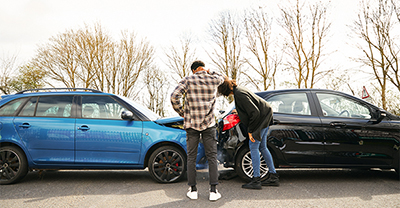Liability car insurance coverage


0 min. read
Liability car insurance definition: Liability car insurance is a type of coverage—required in most states—that can help pay for other people’s medical expenses and damages following a covered accident you cause.
What is liability car insurance?
If you’re at fault in an accident, auto liability insurance can help pay for damage you cause to another person’s vehicle and covers costs for injuries others incur in the accident, up to a certain amount.
Do I need auto liability insurance?
Yes, you likely need auto liability insurance. Most states require you to carry a minimum level of liability insurance to make sure you’re covered up to a certain amount if you’re involved in an accident.
Get a free car insurance quote and review your options.
What does liability car insurance cover?
There are two types of auto insurance liability coverage:
Bodily injury liability coverage
Bodily injury liability coverage applies when other drivers or pedestrians are injured in a covered accident you cause. It may help cover their:
Medical expenses
Legal fees
Lost income
Pain and suffering
Property damage liability coverage
Property damage liability coverage helps pay for damage to another person’s property due to a covered accident.
Liability car insurance coverage limits
Your auto liability insurance policy is made up of three distinct elements.

Bodily injury liability limit per person

Bodily injury liability limit per accident

Property damage liability limit per accident
How to read liability insurance limits
Your auto liability insurance policy is made up of three distinct elements. If your state requires you to hold 25/50/15 (or $25,000/$50,000/$15,000) for auto liability insurance, that means:
$25,000: The maximum bodily injury liability amount your insurance will pay per person injured in an accident
$50,000: The maximum total amount your insurance will pay for bodily injury per accident
$15,000: The total maximum amount your insurance will pay for property damage per accident
Remember, these are just the minimum limits—you can purchase higher limits for additional protection. For example, if you have a $15,000 property damage liability limit and you cause an accident that results in $20,000 in property damage for the other driver, you could be responsible for paying the remaining $5,000 out of pocket. But if you purchase higher limits—like $50,000, hypothetically—you likely wouldn’t have to pay out of pocket.
How much auto liability coverage do I need?
That depends on where you live. Check out your state’s minimum required amount of auto liability insurance below.*
State | Bodily injury liability per person | Bodily injury liability per accident | Property damage liability per accident |
Alabama | $25,000 | $50,000 | $25,000 |
Arizona | $25,000 | $50,000 | $15,000 |
Arkansas | $25,000 | $50,000 | $25,000 |
California | $15,000 | $30,000 | $5,000 |
Colorado | $25,000 | $50,000 | $15,000 |
Connecticut | $25,000 | $50,000 | $25,000 |
Delaware | $25,000 | $50,000 | $10,000 |
Florida | N/A | N/A | $10,000 |
Georgia | $25,000 | $50,000 | $25,000 |
Idaho | $25,000 | $50,000 | $15,000 |
Illinois | $25,000 | $50,000 | $20,000 |
Indiana | $25,000 | $50,000 | $25,000 |
Iowa | $20,000 | $40,000 | $15,000 |
Kansas | $25,000 | $50,000 | $25,000 |
Kentucky | $25,000 | $50,000 | $25,000 |
Maine | $50,000 | $100,000 | $25,000 |
Maryland | $30,000 | $60,000 | $15,000 |
Minnesota | $30,000 | $60,000 | $10,000 |
Mississippi | $25,000 | $50,000 | $25,000 |
Missouri | $25,000 | $50,000 | $25,000 |
Nebraska | $25,000 | $50,000 | $25,000 |
Nevada | $25,000 | $50,000 | $20,000 |
New Mexico | $25,000 | $50,000 | $10,000 |
North Carolina | $30,000 | $60,000 | $25,000 |
Ohio | $25,000 | $50,000 | $25,000 |
Oregon | $25,000 | $50,000 | $20,000 |
Pennsylvania | $15,000 | $30,000 | $5,000 |
South Carolina | $25,000 | $50,000 | $25,000 |
South Dakota | $25,000 | $50,000 | $25,000 |
Tennessee | $25,000 | $50,000 | $25,000 |
Texas | $30,000 | $60,000 | $25,000 |
Utah | $25,000 | $65,000 | $15,000 |
Vermont | $25,000 | $50,000 | $10,000 |
Virginia | $30,000 | $60,000 | $20,000 |
Washington | $25,000 | $50,000 | $10,000 |
West Virginia | $25,000 | $50,000 | $25,000 |
Wisconsin | $25,000 | $50,000 | $10,000 |
Wyoming | $25,000 | $50,000 | $20,000 |
You can purchase more coverage than your state’s required minimum amount, and also add higher limits and additional coverages on your quote.
How much does liability car insurance cost?
If you choose to carry just your state’s minimum requirement of liability insurance and no other types of coverage, you can usually get relatively cheap car insurance. That said, your rates will always depend on a variety of factors including your driving history, where you live, and your age.
What does liability car insurance not cover for an auto accident?
Auto liability insurance coverage doesn't cover everything. For example, it doesn’t cover items and scenarios like:
Expenses for your own bodily injuries or property damage in an accident you cause
Theft
Damage or injuries from hitting an animal
Hail damage
Towing costs
Windshield replacement
Don’t worry—you can purchase other car insurance coverages to help protect against risks not covered by your liability car insurance.
How does liability car insurance protect me?
If you’re determined to be at fault in an accident, your standard liability auto insurance covers the costs of injuries to other drivers and pedestrians, along with property damage.
If you're in an accident where you aren't at fault and the other driver doesn't have insurance, underinsured and uninsured coverages can help protect you. This coverage is in addition to your auto liability insurance coverage and is also a required coverage in many states.
Liability-only insurance policies
Liability-only insurance is the lowest or most basic amount of required coverage you can legally hold for your vehicle. Having a liability-only policy means you’ve opted out of holding any additional coverage—like personal injury or physical damage—and only carry the state-required minimum.
Liability-only vs. “full coverage” car insurance
You’ll often see car insurance companies refer to liability-only and “full coverage” car insurance policies. What’s the difference between these policy types?
First, it’s important to note that “full coverage” isn’t actually a type of car insurance product, because there isn’t a universally agreed-upon definition. Plus, no policy can fully protect you against every conceivable scenario.
But for the sake of discussion, here’s what people usually mean when they say “liability-only” and “full coverage”:
Liability-only car insurance vs. | "Full coverage" car insurance |
|---|---|
Bodily injury liability | Bodily injury liability |
Property damage liability | Property damage liability |
Does liability insurance cover rental cars?
Typically, if you cause an accident while driving your rental car, your liability insurance will apply to that vehicle. To make sure, review your insurance policy or give us a call at 800-334-0090.
Carrying liability car insurance—even the minimum required amount—not only helps keep you legal on the road, it can also help protect you from potentially life-altering costs associated with an accident. When the unexpected happens, it’s reassuring knowing you’re covered.
Related resources
The general information in this blog is for informational or entertainment purposes only. View our blog disclaimer.
*Data accuracy is subject to this article's publication date.










